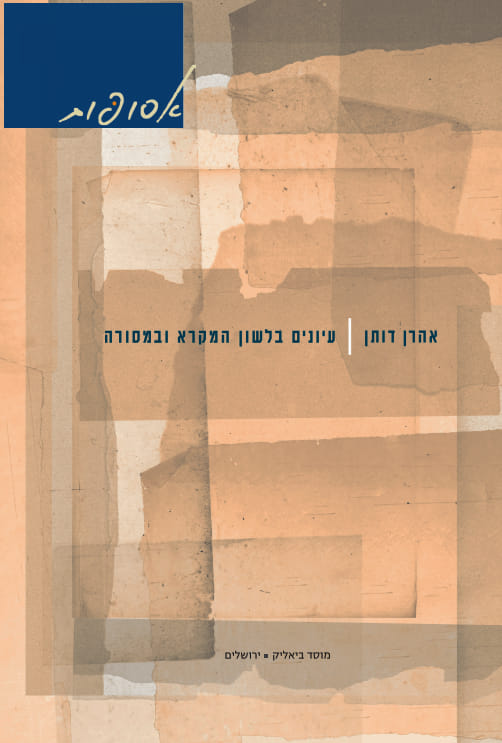Book: Studies in Hebrew Linguistics and Masora, by Aron Dotan

This volume collects together 35 articles from the full range of Aron Dotan’s scholarly interests. The original publications span more than fifty years: the earliest having first appeared back in 1965, while the most recent is the one hitherto unpublished article appearing for the first time in this volume. The articles are arranged thematically, rather than chronologically, into eight sections, each containing between two and six articles. Although three of the studies originally appeared in English, these have been translated for the sake of this volume, such that the entire volume is, appropriately in my view, in Hebrew.
The specialities of Masora and mediaeval grammar encompass numerous subfields: examination of the central biblical manuscripts themselves; study of the various masoretic traditions (Tiberian, Babylonian, Erets-Yisraeli) contained within those manuscripts; the decoding and analysis of the various masoretic treatises that arose as the masoretic enterprise developed; the tracing of the development of grammatical thought as it arose out of masoretic thought and in relation to other semitic grammatical traditions, and so on. And behind each of these sub-specialities lie key mediaeval scholars, whose encyclopaedic minds frequently span multiple fields, and whose oeuvres can be studied in and of themselves. Figures such as Aharon ben Asher, Saʿadia Gaon, and Yehuda Hayyuj.
This collection of essays spans each of the specialities, fields, sub-fields and figures listed above. Six sections of the book comprise: mediaeval linguistics, Masora, manuscripts (focussing principally on the Leningrad Codex and British Library Or. 4445), ben Asher, Saʿadia, and the historical development of the various vocalisation and accentuation traditions. To these six sections are added two apparently extraneous sections: one with the rather general title: ‘Grammatical Issues’ (in which, for example, the appropriate declination of maqṭēl nouns in Modern Hebrew is discussed), and one more exegetical section, containing four brief articles on the meaning of particular biblical phrases. In fact, though, these sections are not really outliers. Rather, they showcase the benefits of paying sustained attention to the full breadth of the mediaeval masoretic and exegetical traditions. The discussion of the appropriate declination of maqṭēl nouns in Modern Hebrew, for example, is informed not only by the biblical and post-biblical data from the Tiberian tradition, but also from the Babylonian and Erets-Yisraeli traditions.
The breadth of Dotan’s scholarship is, quite frankly, astounding, especially when one considers the vast quantity of ăvōḏȃ šəḥōrȃ involved in manuscript work of any kind, and masoretic work in particular. To my mind, this is perhaps one of the key benefits of having so many of Dotan’s articles brought together into one place: his example of mastery over such a breadth of masoretic and mediaeval grammatical scholarship, together with the extraordinary depth and complexity of many of the mines he works, is inspiring.
More pragmatically: the collocation of these articles enables one to get a clearer overview of Dotan’s general approach and methodology, which can, in turn, enable one better to appreciate the individual arguments. One very clear illustration of this is in the eighth and final section of the book, concerning the history of the various vocalisation and accentuation systems. The four articles therein deal with, respectively, (1) the relative chronology between the vowel signs and the accent signs; (2) the development of the accentuation system; (3) the development of the Erets Yisraeli vowel and accent systems; (4) the development of the Babylonian vocalisation system. Having these studies side by side, the reader benefits from the mutual consolidation and elucidation each essay offers to the rest. This sort of cross-pollination between articles has been assisted by Dotan’s efforts to make the terminology more consistent across the full range of the articles (which were written, remember, over a span of more than 50 years!), and by the addition of one full bibliography at the end of the volume to which all the footnotes have been formatted for consistency.
In a Foreward to Dotan’s 2020 volume Thesaurus of Quntrese Ha-Masora: Hidden Language Treasures of Old, Moshe bar Asher laments the fact that Dotan’s seminal Encyclopedia Judaica entry on Masora never appeared in Hebrew. In light of the 2020 volume, and the 2021 volume, could Mosad Bialik see their way to a slim 2022 Dotan volume to rectify this lacuna? And then perhaps a 2023 volume republishing Dotan’s Diqduqe ha-Teamim in a more user-friendly format?

Add new comment